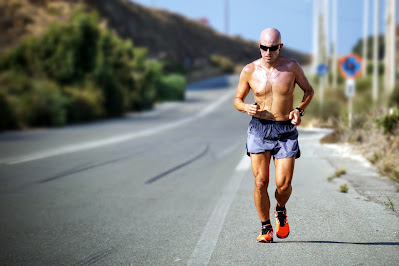Personal safety while jogging
- Get link
- X
- Other Apps
Jogging is an excellent form of exercise that provides numerous physical and mental health benefits. However, it is also important to consider personal safety while participating in this activity. Unfortunately, jogging can sometimes expose individuals to physical threats and environmental hazards. To ensure a safe and enjoyable jogging experience, it is essential to understand the risks and take steps to minimize them.
It is essential to be aware of the risks and hazards that can arise. Physical threats can come in the form of criminal activity, such as theft or assault. Environmental hazards can include poor weather conditions, uneven pavement, and exposure to toxic substances. Jogging during nighttime can also present additional safety concerns, as visibility is reduced, and criminals may take advantage of the lack of onlookers.
To prepare for a safe jogging experience, it is crucial to choose the right gear, plan the route, and carry personal identification. Wearing reflective clothing and using a headlamp during nighttime jogging can significantly improve visibility and safety. It is also important to plan a route that avoids high-crime areas and takes into consideration the weather and visibility conditions. Carrying personal identification, such as a driver's license or ID card, can assist in quickly identifying the jogger in case of an emergency.
While jogging, it is crucial to stay alert and aware of your surroundings. This means being mindful of the people and vehicles around you and paying attention to potential threats. Keeping a low profile by avoiding the use of electronic devices and loud music can also minimize the chances of attracting attention from criminals. Trusting your instincts is also essential, as a gut feeling can often indicate when something is not right. It is also advisable to communicate your whereabouts, such as sending a text or leaving a note with a trusted friend or family member, in case of an emergency.
In the event of an emergency, it is essential to have some basic self-defense techniques in your arsenal. Personal safety devices, such as pepper spray or a personal alarm, can also be useful in deterring criminals and attracting attention. In emergency situations, it is essential to seek help as soon as possible. This may involve calling law enforcement, running to a nearby business or residence, or using a personal safety device to attract attention.
By taking such precautions, individuals can enjoy the many benefits of jogging while minimizing the risks. Remember, personal safety should always be a top priority, and it is better to be prepared and take the necessary precautions to stay safe while jogging.
Understanding the Risks
Understanding the risks associated with jogging is crucial to ensure a safe and enjoyable experience. While jogging can provide numerous physical and mental health benefits, it is essential to be aware of the dangers and hazards that can arise. By understanding the risks, individuals can take the necessary precautions to minimize them and enjoy the benefits of jogging.
Physical Threats Physical threats to personal safety while jogging can come in the form of criminal activity, such as theft or assault. Criminals may target joggers for their valuables, such as cell phones, wallets, and jewelry. Jogging in isolated or poorly lit areas can increase the risk of criminal activity and make the jogger an easy target. To minimize the risk of theft or assault, it is essential to avoid jogging in high-crime areas, stay alert and aware of your surroundings, and keep valuables out of sight.
Environmental Hazards Environmental hazards while jogging can include poor weather conditions, uneven pavement, and exposure to toxic substances. Jogging in inclement weather, such as heavy rain or strong winds, can be dangerous and increase the risk of slip and fall accidents. Uneven pavement can also pose a risk, as it can cause tripping or falling. Exposure to toxic substances, such as gasoline or chemicals, can be harmful to health and should be avoided while jogging. To minimize the risk of environmental hazards, it is essential to choose a safe jogging route, wear appropriate footwear, and avoid jogging in areas with toxic substances.
Safety Concerns During Nighttime Jogging Jogging during nighttime can present additional safety concerns, as visibility is reduced, and criminals may take advantage of the lack of onlookers. To minimize the risk of criminal activity during nighttime jogging, it is essential to wear reflective clothing and use a headlamp to increase visibility. Planning the route to avoid high-crime areas and avoiding the use of electronic devices and loud music can also reduce the chances of attracting attention from criminals.
Understanding the risks associated with jogging is crucial to ensuring a safe and enjoyable experience. Physical threats, such as theft or assault, and environmental hazards, such as poor weather conditions or uneven pavement, can pose a risk to personal safety while jogging. Nighttime jogging can also present additional safety concerns due to reduced visibility and increased criminal activity. By being aware of these risks and taking the necessary precautions, individuals can minimize the dangers and enjoy the benefits of jogging.
Preparing for Safe Jogging
Preparing for safe jogging is essential for a successful and injury-free experience. With the proper preparation, individuals can minimize the risks and ensure a safe and enjoyable jogging experience. The following are some tips for preparing for safe jogging.
Selecting a safe jogging route is crucial for avoiding physical and environmental hazards. Jogging in well-lit, populated areas can reduce the risk of criminal activity, while jogging on well-maintained trails or paths can minimize the risk of slip and fall accidents. Planning your route ahead of time can also help to avoid dangerous intersections and high-traffic areas.
Wearing appropriate clothing and footwear while jogging can improve comfort and reduce the risk of injury. Lightweight, breathable clothing can help regulate body temperature, while shoes with good support and traction can reduce the risk of slip and fall accidents. Reflective clothing can also increase visibility during nighttime jogging.
Staying hydrated and fueled during jogging is essential for maintaining energy and preventing dehydration. Drinking plenty of water before, during, and after jogging, and carrying a water bottle or hydration pack can help ensure proper hydration. Eating a balanced meal or snack before jogging can also help to provide energy and prevent fatigue.
Staying alert and aware of your surroundings while jogging is essential for avoiding hazards and staying safe. Avoid using electronic devices while jogging, as they can distract from your surroundings and make you an easier target for criminals. Keeping your head up and looking around can also help you stay alert and aware of your surroundings.
Carrying personal safety devices, such as a personal alarm or pepper spray, can provide added protection during jogging. Personal alarms can be activated to alert others in case of an emergency, while pepper spray can be used to deter attackers. It is important to familiarize yourself with how to use these devices before jogging.
Staying Safe on the Jog
Staying safe while jogging is crucial for avoiding hazards and ensuring a successful and injury-free experience. By following a few simple tips, individuals can minimize the risks and enjoy the numerous physical and mental health benefits of jogging. The following are some tips for staying safe while jogging.
Staying alert and aware of your surroundings while jogging is essential for avoiding hazards and staying safe. Avoid using electronic devices while jogging, as they can distract from your surroundings and make you an easier target for criminals. Keeping your head up and looking around can also help you stay alert and aware of your surroundings. If you feel uneasy or uncomfortable in a particular area, trust your instincts and find a different route.
Varying your jogging route can reduce the risk of criminal activity and provide a more interesting jogging experience. Jogging in well-lit, populated areas can reduce the risk of criminal activity, while changing your route can reduce the chances of encountering the same hazards repeatedly.
Staying visible while jogging can increase safety, especially during nighttime jogging. Wearing reflective clothing and using a headlamp can increase visibility and make you more noticeable to others. Staying visible can also reduce the risk of accidents, as drivers and cyclists are more likely to see you when you are visible.
Bring a Friend Bringing a friend along while jogging can provide added safety and a more enjoyable experience. Jogging with a partner can reduce the risk of criminal activity, as there are two people to keep an eye out for potential hazards. Jogging with a friend can also provide motivation and accountability, making it easier to stick to a jogging routine.
By following these tips, individuals can enjoy the numerous physical and mental health benefits of jogging while staying safe.
Self-defense Techniques
Self-defense techniques can provide individuals with the necessary skills to protect themselves in dangerous situations. While it is important to stay alert and aware of your surroundings, having the knowledge and ability to defend yourself can provide an extra layer of protection and peace of mind. The following are some common self-defense techniques that individuals can learn to improve their personal safety.
The first line of defense in any self-defense situation is awareness and avoidance. This means staying alert and aware of your surroundings, and taking steps to avoid potentially dangerous situations. For example, avoiding dark and isolated areas, being cautious of people who appear suspicious, and leaving a situation if it feels unsafe.
Verbal self-defense involves using words and body language to deter an attacker or defuse a potentially dangerous situation. Verbal self-defense can include assertively stating boundaries, using a confident and strong tone, and maintaining eye contact. In some cases, verbal self-defense may be enough to deter an attacker, and individuals can avoid a physical confrontation.
Physical Self-Defense Physical self-defense involves using physical techniques to defend oneself from an attacker. Physical self-defense can include strikes, kicks, and joint locks, and should only be used as a last resort when all other options have been exhausted. Physical self-defense techniques should only be used in response to an imminent physical threat, and individuals should be aware of the potential consequences of using physical force.
- Get link
- X
- Other Apps


